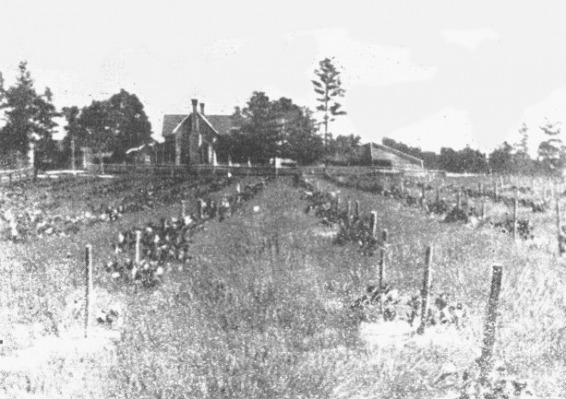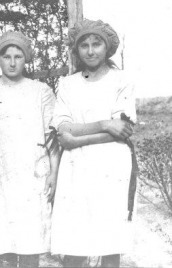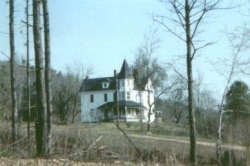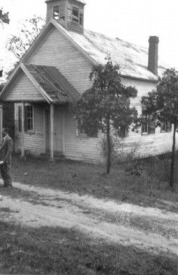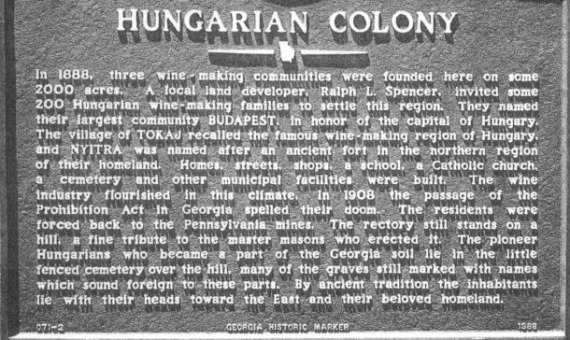Prelude to the Haralson County Wine Boom
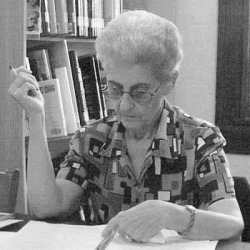
by Peggy Kimball (Nov 04)
After a two-year absence from Haralson County, Ralph L. Spencer returned and immediately began an elaborate plan for a town site. The site was plotted east of Tallapoosa on what is now Highway 78. The lots were drawn out for a church and a business district. Spencer then organized the Georgia Fruit Growing and Winery Association.
Spencer knew that the business of growing grapes for wine was a specialized field and would require experts to ensure success. During his absence, he apparently had done his homework. He secured the help of specialists: one was a Catholic priest named Father Janishek. To encourage Father Janishek to move to the area, Spencer promised a home, a horse and a buggy. Another specialist he recruited knew of Hungarian farmers who were working in the coal mines of Pennsylvania. Plans were immediately put into effect to recruit these farmers to move to Haralson County. They would establish the town and plant the vineyards.
Over 50 families responded and established the community, naming it Budapest in honor of Budapest, Hungary. The vineyards flourished and each family was allotted ten acres. Two were already planted; the other eight were to be planted by the family.
Spencer knew that the business of growing grapes for wine was a specialized field and would require experts to ensure success. During his absence, he apparently had done his homework. He secured the help of specialists: one was a Catholic priest named Father Janishek. To encourage Father Janishek to move to the area, Spencer promised a home, a horse and a buggy. Another specialist he recruited knew of Hungarian farmers who were working in the coal mines of Pennsylvania. Plans were immediately put into effect to recruit these farmers to move to Haralson County. They would establish the town and plant the vineyards.
Over 50 families responded and established the community, naming it Budapest in honor of Budapest, Hungary. The vineyards flourished and each family was allotted ten acres. Two were already planted; the other eight were to be planted by the family.
a new vineyard in Haralson County (date unknown)
The Farmers proved they were masters of the task as the grapes grew in abundance, with clusters ranging from 10-12 inches in length. The Hungarian Village was a successful venture - the surrounding hillsides were covered with homes and vineyards. At harvest time, the brimming baskets showed the evidence of much hard work.
The Hungarian village was so successful that a group of [Slovaks] arrived and settled a village called Nitra. The village was located on what is now called Old Ridgeway Road west of Waco. Overlooking the village a home was built for Father Janishek. This beautiful building still stands near Devil's Kitchen. The home has thirteen rooms and a domed cupola that extends well beyond the second floor. The house is now privately owned.
At its peak, Nitra had 60 dwellings, a church and a general store. Now that Spencer had a successful project, wineries were built to take care of the abundance of grapes. The people were hard-working and sober. They had many talents such as cheese and bread making as well as preserving fruits. The homes were small and well kept. One is still standing on Highway 78, a lowly cottage with gingerbread trim and magnolia trees in the yard.
|
Click image for photos of Budapest cemetery
|
Things changed... with the introduction of the Prohibition Act. The law banned all fermented beverages. and there was no other market for the grapes. The soil was not suited for farming and people were without jobs. They began to leave the area, not bothering to sell their homes. A few remained and tilled the red clay as best as they could.
While the majority of these people are gone from Haralson County and little remains of these hardworking people, there are a few descendents who chose to stay here. The Church was abandoned and in the 1970s, the building burned. There is a cemetery that became overgrown, but recently community workers have cleaned the site up. The headstones tell a story all their own. On the few original headstones in the cemetary the word "Peace" is carved. These people came to Haralson County in search of a new life. They worked hard in the red hills of Georgia. While they didn't find what they were looking for, they found peace in a new land for a short time in Haralson County. |
______________________________________________________________________________
Estavanko Family photographs
|
working in the vineyard, the Estavankos: Pauline (left) and Catherine, "Kate" (right)
Catholic priest rectory
Nitra, Georgia (1991) |
Tallapoosa, Georgia 1896-1898
L-to-R: The Estavankos- Jacob, Joseph and Mary (Czimar) Saint Joseph Catholic Church
Budapest, Georgia (October 1950) Man at left edge is Joseph M. Estavanko. |
______________________________________________________________________________
Hungarian Colony Marker
The circumstances under which the now-missing marker above may have disappeared are the subject of an extended essay, which also touches upon a number of interesting aspects of county history. As this is written in March 2009, there is a $200 reward for information leading to the recovery of the missing marker.
_______________________________________________________________________________
Learn more about Hungarian cuisine.
_______________________________________________________________________________
See DVHH Destination The Americas United States Tallapoosa-Budapest, Georgia, GA which includes numerous photographs, at the Web site of the Donauschwaben Helping Hands Project
_______________________________________________________________________________
Read more about the role of this episode in the history of the Roman Catholic church in Georgia.
_______________________________________________________________________________
Read more about the history of viticulture in Georgia. It writes in part:
"An 1896 map reveals that vineyards then covered approximately 12,726 acres of land in Haralson County, Georgia."
Perhaps this number is a bit more reliable than the knowledge of geography evidenced in this work: Haralson County is in northWEST Georgia!
"An 1896 map reveals that vineyards then covered approximately 12,726 acres of land in Haralson County, Georgia."
Perhaps this number is a bit more reliable than the knowledge of geography evidenced in this work: Haralson County is in northWEST Georgia!
Proudly powered by Weebly
